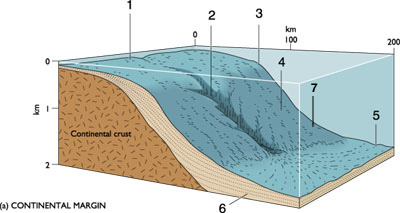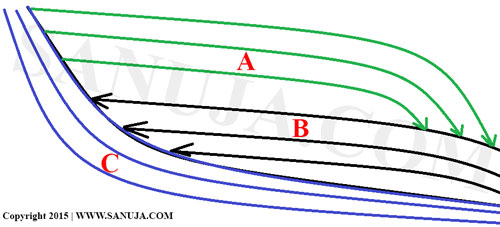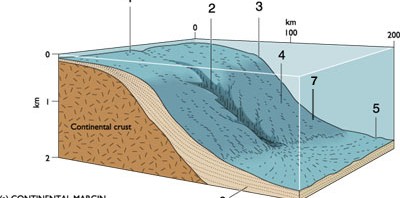Disclaimer: While every reasonable effort is made to ensure that the information provided is accurate, no guarantees for the currency or accuracy of information are made. It takes several proof readings and rewrites to bring the quiz to an exceptional level. If you find an error, please contact me as soon as possible. Please indicate the question ID-Number or description because server may randomize the questions and answers.
Go to: Midterm I | Midtrem II
Geology (GLGY 381-UCAL) Final Exam
Congratulations - you have completed Geology (GLGY 381-UCAL) Final Exam.
You scored %%SCORE%% out of %%TOTAL%%. With incorrect multiple attempts your score is %%PERCENTAGE%%
Your performance has been rated as %%RATING%%
Question 1 |
A | backbulge |
B | foredeep |
C | wedgetop |
D | forebulge |
Question 2 |
What type of collision occur at the area marked with F? (ID-SSF-39)

A | Interarc Basin |
B | Subduction Complex |
C | Rifted Margin Prism |
D | Trench |
E | Magmatic Arc |
Question 3 |
A | Progradation |
B | Increase in accommodation space |
C | Regression Hint: Close, but this is not the right term! |
D | Rising sea level |
E | Transgression |
Question 4 |
A | I. coarsening upwards II. fining upwards III. fining upwards |
B | I. fining upwards II. fining upwards III. fining upwards |
C | I. fining upwards II. coarsening upwards III. fining upwards |
D | I. fining upwards II. fining upwards III. coarsening upwards |
E | I. fining upwards II. coarsening upwards III. coarsening upwards |
Question 5 |
A | active zone. |
B | photic zone. |
C | coral reef zone. |
D | passive zone. |
Question 6 |
A | Yes |
B | No |
Question 7 |
A | counter clockwise direction. (if you take to a bloody British, it will bloody anti-clockwise 🙂 |
B | clockwise direction. |
C | upwards at 90 degrees to the rotational face. |
D | downwards at 90 degrees to the rotational face. |
Question 8 |
In which area would you expect to find the passive margin (choose from red letters)? (ID-SSF-41)

A | H |
B | P |
C | R |
D | T |
E | N |
Question 9 |
A | angular unconformity. |
B | paraconformity |
C | disconformity |
D | a hiatus. |
E | a conformity. |
Question 10 |
A | The first term describes the seawards movement of the shoreline and the second term describes the landwards movement of the shoreline. |
B | The first term describes the landwards movement of the shoreline and the second term describes the seawards movement of the shoreline. |
C | The first term is used in depositional descriptions and the second term is used in fluvial descriptions. |
D | They are the same; therefore the question is wrong. |
Question 11 |
A | True |
B | False |
Question 12 |
A | continental volcanoes |
B | transform faulting |
C | hot spots |
D | sea-floor spreading and mid-ocean ridges |
E | subduction and trenches |
Question 13 |
A | analytical |
B | temporal |
C | spatial |
D | theoretical |
E | practical |
Question 14 |
A | forebulge |
B | wedgetop |
C | backbulge |
D | foredeep |
E | suckdeep |
Question 15 |
A | Flase |
B | True |
Question 16 |
A | Rise in relative sea-level and movement of the shoreline seawards. |
B | None of the answers listed here are correct. |
C | Fall in relative sea-level and movement of the shoreline landwards. |
D | Rise in relative sea-level and movement of the shoreline landwards. |
E | Fall in relative sea-level and movement of the shoreline seawards. |
Question 17 |
A | beds |
B | supergroups |
C | formations |
D | members |
E | groups |
Question 18 |
A | Global sea level will be increase as the new oceanic crust takes up space in basins. |
B | Global sea level will be decrease as new oceanic crust is formed due to spreading. |
C | Sediment influx will be significantly decreased as deposited sediments within the accommodation space is used up to produce new oceanic crust. |
D | Active spreading ridges would have no impact on either sediment influx or global sea levels because this activity will be balanced through subduction. |
E | Sediment influx will be significantly increased as continental crust is pushed further upwards resulting greater erosion. |
Question 19 |

A | 4 |
B | 3 |
C | 5 |
D | 7 |
E | 6 |
Question 20 |
What type of collision can occur at the area marked with N? (ID-SSF-38)

A | Continent-Ocean Collision |
B | Active Margin Collision |
C | Passive Margin Collision |
D | Continent-Continent Collision |
E | Ocean-Ocean Collision |
Question 21 |
A | At first terrigenous clastic supply will rapidly increase the carbonate productivity, but in the long run it will create chemical barriers reducing carbonate productivity. |
B | Increased terrigenous clastic supply reduces carbonate productivity. |
C | At first it will rapidly decrease the carbonate productivity, but in the long run it will increase the carbonate productivity as terrigenous clastic supply will introduce essential chemical components to the system. |
D | There is no effect because the carbonate productivity is independent of terrigenous clastic supply. |
Question 22 |
A | Decrease in relative sea level and uplift occurring at the same time. |
B | Increase in relative sea level and uplift occurring at the same time. |
C | Increase in relative sea level and increase in subsidence the same time. |
D | Increase in relative sea level and increased in sediment input at the same time. |
E | Decrease in relative sea level and increased in sediment input at the same time. |
Question 23 |
A | Discharge, subsidence and accommodation are associated with hinterland and subsidence is associated with basin. |
B | Discharge and relief are associated with hinterland and accommodation and subsidence are associated with basin. |
C | Discharge and subsidence are associated with hinterland and accommodation is associated with basin. |
D | Discharge and relief are associated with hinterland and accommodation and slope is associated with basin. |
E | Discharge, relief and subsidence are associated with hinterland and accommodation is associated with basin. |
Question 24 |
A | The line between the lateral contact of two sets of widely different strata. |
B | An unexplained nonconformity. |
C | A discontinuity in the age of strata due to lack of deposition. |
D | A sudden increase of deposition in a specific window of geologic time. |
Question 25 |
A | First-order |
B | Third-order |
C | Second-order |
D | It is based on the type of tectonic and basinal setting. |
Question 26 |
A | Foreset |
B | Bottomset |
C | Distalset |
D | Topset |
Question 27 |
A | Aggradational |
B | Progradational |
C | Transgressional |
D | Retogradational |
Question 28 |
A | paraconformities. |
B | abyssal plains.. |
C | basins. |
D | disconformities. |
Question 29 |
A | Sediments will be mostly filled in the continental shelf with very little to no sed deposition on the basin. |
B | Accommodation space always will be deceased significantly. |
C | Accommodation space will be moved towards the shoreline. |
D | Sediments will be mostly filled in the basin bypassing the deposition process on the continental shelf. |
Question 30 |
A | transgression |
B | regression |
C | regression and transgression |
D | forced regression |
E | regression and forced regression |
Question 31 |
A | oceanic shelf. |
B | continental boundary. |
C | continental shelf. |
D | the mid ocean ridge. |
E | the basin. |
Question 32 |
A | Dominant muddy deposits in distal regions |
B | Fining upward |
C | Dominant sandy deposits at the base |
D | Coarsening upward |
Question 33 |
If you were to indicate the boundary between the Indian-Asian crust, where would it be (choose from red letters)? (ID-SSF-40)

A | F |
B | L |
C | B |
D | D |
E | A |
Question 34 |
A | False because it can only preserve up to about half a million years. |
B | True |
C | False because it can preserve only up to few thousands of years because tidal currents disturb the depositional process. |
Question 35 |

A | 5 |
B | 1 |
C | 4 |
D | 2 |
E | 3 |
Question 36 |
A | sudden decrease in regional sed load. |
B | sudden increase in regional sed load. |
C | highstand |
D | rise in sea level |
E | lowstand |
Question 37 |
A | False |
B | True |
Question 38 |
A | True |
B | False |
Question 39 |
A | A. Non-oscillating B. Oscillating |
B | A. Oscillating B. Non-oscillating |
C | A. high B. low |
D | A. low B. high |
Question 40 |
A | wedgetop |
B | forebulge |
C | backbuldge |
D | foredeep |
E | foreland |
F | basin |
G | channel |
Question 41 |
A | Global tectonics |
B | Transgression |
C | Rate of chemical weathering |
D | Forced regression |
E | Regression |
Question 42 |
A | Retrogradation |
B | Lowstand |
C | Highstand |
D | Warm and wet seasons |
Question 43 |

A | 1 |
B | 5 |
C | 4 |
D | 3 |
E | 2 |
Question 44 |
A | True |
B | False |
Question 45 |
A | inner the inner shelf |
B | near the shore line |
C | near the wave base |
D | near the mid ocean ridge |
Question 46 |
A | When dealing with areas that is difficult to access. |
B | When analyzing data collected in a small region. |
C | When analyzing fossils and chemical composition (carbon) to date formations. |
D | When analyzing data collected from a large region. |
Question 47 |
A | Extremely high subsidence |
B | Extremely low subsidence |
C | Mud and silt dominated deposits |
D | Sand dominated deposits |
E | Gravel dominated deposits |
Question 48 |

A | 2 |
B | 4 |
C | 3 |
D | 1 |
E | 7 |
Question 49 |
A | They carry sediments on top of sea waters for a long distances out into the ocean before settling to the bottom. |
B | They drive the forces needed for delta formation. |
C | They are typically associated with low density sediment loads. |
D | They often result in turbidites deposition. |
E | They only occurred in the per-Cambrian and no longer observed in modern day environments. |
Question 50 |
A | The pressure on both sides of the continental or oceanic boundaries must be at equilibrium. |
B | The force of the load due to gravity must be large enough to overcome the forces within the crust resulting flexure. |
C | The forces within the crust should exceed the forced applied on the crust by the load resulting flexure. |
D | I have no clue what the hell you are talking about. I hate applied principles of geology. Hint: Since you have pick this one, I suggest that you click and open the renaming choices just to read what it was.....? |
Question 51 |
A | downlap |
B | toplap |
C | erosional surface |
D | onlap |
Question 52 |
A | A. Highstand
B. rising inflection point (RIP) |
B | A. Lowstand
B. falling inflection point (FIP) |
C | A. Rising inflection point (RIP)
B. highstand |
D | A. Highstand
B. falling inflection point (FIP) |
E | A. Highstand
B. rising inflection point (RIP) |
Question 53 |
A | near paraconformities |
B | near nonconformities |
C | on the volcanic arc |
D | on the basin floor fan. |
E | near mid ocean ridges(MOR) |
Question 54 |
A | True |
B | False |
Question 55 |
What letter on the following cartoon represent the toplap-downlap sequence? (yes, it is a two different things, so watch out!) (ID-SSF-44)

A | B and C |
B | A and C |
C | A |
D | C |
E | A and B |
F | B |
Question 56 |
A | Long term variations in the rate of sea floor spreading and subduction which result in global sea-level changes. |
B | Long term variations in the volume of glaciers which result in global sea level changes. |
C | Long term variations in the orbit of the Earth which result in changes in climate. |
D | Long term variation in atmospheric conditions which results in global changes in sedimentary processes. |
E | Long term variations in global temperatures that is caused by natural cycles of the Sun. |
Question 57 |
A | counter clockwise direction. (if you take to a bloody British, it will bloody anti-clockwise 🙂 |
B | downwards at 90 degrees to the rotational face. |
C | clockwise direction. |
D | upwards at 90 degrees to the rotational face. |
Question 58 |
A | A. increases B. increases |
B | A. decreases B. decreases |
C | A. decreases B. increases |
D | A. increases B. decreases |
Question 59 |
A | Eustasy |
B | Relative base level |
C | Rifting mechanisms |
D | Global tectonics |
E | Rate of chemical weathering |
Question 60 |
A | more basaltic |
B | more mafic |
C | more denser |
D | more granitic |
Question 61 |
A | Hiatus |
B | Angular unconformity |
C | Nonconformity |
D | Paraconformity |
E | Disconformity |
Question 62 |
A | storm surge. |
B | torpedo rise. |
C | super elevation. Hint: READ THE QUESTION CAREFULLY. |
D | super surge. |
Question 63 |
A | None of the answers are correct. |
B | Sediment load |
C | Tectonics such as subsidence and uplift |
D | Climate and weather |
E | Velocity of rivers |
Question 64 |
A | margins with high slope basements. |
B | active margins. |
C | passive margins. |
D | volcanic regions. |
Question 65 |
A | transgredation |
B | aggradation |
C | progradation |
D | retogradation |
Question 66 |
A | Coastal plain deposits |
B | Muddy deposits |
C | Clastic deposits |
D | Sandy deposits |
Question 67 |
The Magmatic Arc is represented by... (choose from red letters) (ID-SSF-42)

A | C |
B | A |
C | B |
D | E |
E | D |
Question 68 |
A | Fan deltas |
B | Tide-dominated deltas |
C | Wave-dominated deltas |
D | None of the answers are correct |
← |
List |
→ |
| 1 | 2 | 3 | 4 | 5 |
| 6 | 7 | 8 | 9 | 10 |
| 11 | 12 | 13 | 14 | 15 |
| 16 | 17 | 18 | 19 | 20 |
| 21 | 22 | 23 | 24 | 25 |
| 26 | 27 | 28 | 29 | 30 |
| 31 | 32 | 33 | 34 | 35 |
| 36 | 37 | 38 | 39 | 40 |
| 41 | 42 | 43 | 44 | 45 |
| 46 | 47 | 48 | 49 | 50 |
| 51 | 52 | 53 | 54 | 55 |
| 56 | 57 | 58 | 59 | 60 |
| 61 | 62 | 63 | 64 | 65 |
| 66 | 67 | 68 | End |
Credits: Based on the excellent class notes provided by, Dr. Melissa Giovanni during Fall 2012.
FAQ | Report an Error
